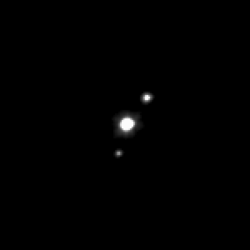 Hubble Space Telescope image of 1996 TO66 taken in 2005 | |
| Discovery | |
|---|---|
| Discovered by | |
| Discovery date | 12 October 1996 |
| Designations | |
| (19308) 1996 TO66 | |
| |
| Orbital characteristics [2] | |
| Epoch 13 January 2016 (JD 2457400.5) | |
| Uncertainty parameter 3 | |
| Observation arc | 7322 days (20.05 yr) |
| Aphelion | 48.375 AU (7.2368 Tm) |
| Perihelion | 37.939 AU (5.6756 Tm) |
| 43.157 AU (6.4562 Tm) | |
| Eccentricity | 0.12090 |
| 283.52 yr (103,555 d) | |
| 137.16° | |
| 0° 0m 12.515s / day | |
| Inclination | 27.4948° |
| 355.2889° | |
| 239.07° | |
| Earth MOID | 37.0117 AU (5.53687 Tm) |
| Jupiter MOID | 33.0091 AU (4.93809 Tm) |
| Physical characteristics | |
| Dimensions | |
| 7.92 h (0.330 d) | |
| 7.92 h [2] | |
| 0.7 (assumed) | |
| Temperature | ~43 K |
| 4.5 | |
(19308) 1996 TO66 (provisional designation 1996 TO66) is a trans-Neptunian object that was discovered in 1996 by Chadwick Trujillo, David Jewitt and Jane Luu. Until 20000 Varuna was discovered, it was the second-brightest known object in the Kuiper belt, after Pluto.

